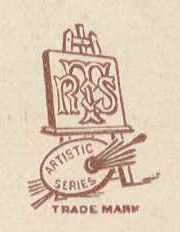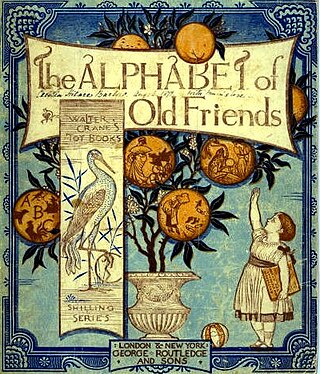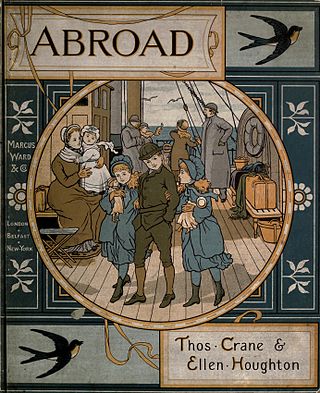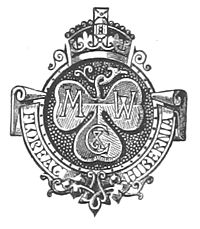
Catherine Greenaway was an English Victorian artist and writer, known for her children's book illustrations. She received her education in graphic design and art between 1858 and 1871 from the Finsbury School of Art, the South Kensington School of Art, the Heatherley School of Art and the Slade School of Fine Art. She began her career designing for the burgeoning holiday card market, producing Christmas and Valentine's cards. In 1879 wood-block engraver and printer, Edmund Evans, printed Under the Window, an instant best-seller, which established her reputation. Her collaboration with Evans continued throughout the 1880s and 1890s.

A Christmas card is a greeting card sent as part of the traditional celebration of Christmas in order to convey between people a range of sentiments related to Christmastide and the holiday season. Christmas cards are usually exchanged during the weeks preceding Christmas Day by many people in Western society and in Asia. The traditional greeting reads "wishing you a Merry Christmas and a Happy New Year". There are innumerable variations on this greeting, many cards expressing more religious sentiment, or containing a poem, prayer, Christmas song lyrics or Biblical verse; others focus on the general holiday season with an all-inclusive "Season's greetings". The first modern Christmas card was by John Calcott Horsley.
American Greetings Corporation is a privately owned American company and is the world's second largest greeting card producer behind Hallmark Cards. Based in Westlake, Ohio, a suburb of Cleveland, the company sells paper greeting cards, electronic greeting cards, gift packaging, stickers and party products. In addition, the company owns the Carlton Cards, Tender Thoughts, Papyrus, Recycled Paper Greetings and Gibson brands.

Card making is the craft of hand-making greeting cards. Many people with interests in allied crafts such as scrapbooking and stamping have begun to use their skills to start making handmade cards. This has contributed to cardmaking becoming a popular hobby.

A greeting card is a piece of card stock, usually with an illustration or photo, made of high quality paper featuring an expression of friendship or other sentiment. Although greeting cards are usually given on special occasions such as birthdays, Christmas or other holidays, such as Halloween, they are also sent to convey thanks or express other feelings.

The Sunday Life is a tabloid newspaper in Northern Ireland and has been published since 23 October 1988. It is the sister paper of The Belfast Telegraph and is owned by Independent News & Media.

Louis Prang was an American printer, lithographer, publisher, and Georgist. He is sometimes known as the "father of the American Christmas card".

Edmund Evans was an English wood-engraver and colour printer during the Victorian era. He specialized in full-colour printing, a technique which, in part because of his work, became popular in the mid-19th century. He employed and collaborated with illustrators such as Walter Crane, Randolph Caldecott, Kate Greenaway and Richard Doyle to produce what are now considered to be classic children's books. Little is known about his life, although he wrote a short autobiography before his death in 1905 in which he described his life as a printer in Victorian London.

Hallmark Cards, Inc. is a private, family-owned American company based in Kansas City, Missouri. Founded in 1910 by Joyce Hall, Hallmark is the oldest and largest manufacturer of greeting cards in the United States. In 1985, the company was awarded the National Medal of Arts.
Donald John Lewin OBE is a British businessman. He is the founder and former chairman of Clinton Cards, a chain of greeting cards shops in the United Kingdom. He and his family were estimated to be worth £139 million in 2008.

Raphael Tuck & Sons was a business started by Raphael Tuck and his wife in Bishopsgate in the City of London in October 1866, selling pictures and greeting cards, and eventually selling postcards, which was their most successful line. Their business was one of the best known in the "postcard boom" of the late 1890s and early 1900s. During the Blitz, the company headquarters, Raphael House, was destroyed, including the originals for most of their series. The company never fully recovered.

Toy books were illustrated children's books that became popular in England's Victorian era. The earliest toy books were typically paperbound, with six illustrated pages and sold for sixpence; larger and more elaborate editions became popular later in the century. In the mid-19th century picture books began to be made for children, with illustrations dominating the text rather than supplementing the text.

Under the Window: Pictures & Rhymes for Children was Kate Greenaway's first children's picture book, composed of her own verses and illustrations. Selling over 100,000 copies, the toy book was a commercial success, helped launch Greenaway's career as a children's book illustrator and author in the late 19th century as well as starting what became known as the "Greenaway vogue".

Hugh Thomson was an Irish Illustrator born at Coleraine near Derry. He is best known for his pen-and-ink illustrations of works by authors such as Jane Austen, Charles Dickens, and J. M. Barrie. Thomson inaugurated the Cranford School of illustration with the publication of the 1891 Macmillan reissue of Mrs. Gaskell's Cranford.

Laura Seddon Greeting Card Collection is a collection of 19th to early 20th century British greeting cards, housed in the All Saints Library of Manchester Metropolitan University, England. The collection contains 32,000 cards by various publishers, including Britain's first commercially-produced Christmas card. Laura Seddon donated her collection to the university in 1992.

Thomas Crane (1843–1903) was an English illustrator and art director at Marcus Ward & Co. known for his colourful children's books and decorative greeting cards which often incorporated floral motifs.

John George Sowerby (1849–1914) was an English painter and illustrator from Gateshead, and director of Ellison Glass Works, the Sowerby family business, which during the 1880s was the largest producer of pressed glass in the world. The grandson of naturalist James Sowerby, his paintings were exhibited in the Royal Academy of Arts, and his children's book illustrations were generally well received.
The Rust Craft Greeting Card Company was an American greeting card, printing company and owner of television stations.

A Rugby card is a type of trading card relating to rugby football codes, usually printed on cardboard, silk, or plastic. These cards are most often found in the Australia, New Zealand and other countries where the sport is popular.




















